jueves, 27 de diciembre de 2012
aerodynamic designs over 90 years ago
miércoles, 26 de diciembre de 2012
Pipe roughness and flow
people tend to polish and and grind all the casting marks on the intake manifold or cylinder head.
as you can see in the graph, a laminar flow speed is higher than turbulent, and also the flow speed raises in the middle of the pipe. so how a pipe with no casting marks and a surface less rough can change the speed and flow?
a practical approach in the flowbench shows me that there is almost no difference between a polished surface and a OEM finish surface.
a theoretical approach, for a pipe 120mm long, with 40mm diammeter , a pipe roughness of 1e-15 (almost pvc or plastic surface), 990mbar of pressure, there is an air velocity of 253.528m/s.
with a pipe roughness of cast iron, which is 4.5e-5, the air velocity is 253.524m/s, a 0.04m/s difference.
lets see how affects this air velocity change in flow. for a 40mm diammeter pipe of 120mm length, with an air velocity of 253.528m/s (roughness almost plastic or pvc) . Flow rate is 675.05 cubic foot per minute.
with a cast iron surface, air velocity of 253.524m/s flow rate is 675.06 cubic foot per minute.
in an ideal world and an efficient engine, 1 horsepower drinks 1.4CFM, so don't waste your time polishing surfaces...
martes, 18 de diciembre de 2012
lunes, 17 de diciembre de 2012
CNC ON
finally managed to connect everything and check if it works...
domingo, 16 de diciembre de 2012
jaas garage vs toda racing japan
i sold almost everything from my race car except the engine and coilovers. the engine was laying in the floor
of the mezzanine for about 7months. due to the difficulty of selling this engine, i thought to flow the cylinder head, which was worked by Toda Racing in Japan. I sent it 3 years ago, when i knew nothing ( still learning every day) about cylinder heads, flows and the physics involved in this world.
i was very curious about how it will perform against my cylinder head designs. worked hard friday night to
strip down my engine . Got a little surprise with a marked cylinder wall. great for an engine with less than 1000km !
the worked cylinder head from japan, flowed just¨8CFM more than a stock cylinder head. just 8CFM more.
of the mezzanine for about 7months. due to the difficulty of selling this engine, i thought to flow the cylinder head, which was worked by Toda Racing in Japan. I sent it 3 years ago, when i knew nothing ( still learning every day) about cylinder heads, flows and the physics involved in this world.
i was very curious about how it will perform against my cylinder head designs. worked hard friday night to
strip down my engine . Got a little surprise with a marked cylinder wall. great for an engine with less than 1000km !
the worked cylinder head from japan, flowed just¨8CFM more than a stock cylinder head. just 8CFM more.
miércoles, 12 de diciembre de 2012
K20A head
done another k20a head. similar numbers in intake side,but less flow in the exhaust side. in stock form the exhaust flowed 20cfm less than a previous head i've done. the gains were +- 24CFM intake and +-40CFM in exhaust.
jueves, 6 de diciembre de 2012
K20a intake manifold
time ago started builing an intake manifold based on the PRB manifold. due to lack of time i forgot it, but ith some time this week, i redesigned and started again this manifold.
compared to the original prb manifold, gained 48CFM and compared to RSP manifold, gained 26CFM.
i am told that the RRC manifold, the best OEM manifold for a K20A engine, flows about 326CFM. i am close to that numbers, with 324CFM.
this manifold is for a drag race car with a high reving engine(9300RPM), so the runners are short, wider with a bigger plenum, a little more than 2 liter. it's a prototype, so, lets see if works or not.
compared to the original prb manifold, gained 48CFM and compared to RSP manifold, gained 26CFM.
i am told that the RRC manifold, the best OEM manifold for a K20A engine, flows about 326CFM. i am close to that numbers, with 324CFM.
this manifold is for a drag race car with a high reving engine(9300RPM), so the runners are short, wider with a bigger plenum, a little more than 2 liter. it's a prototype, so, lets see if works or not.
hand made dome. needs a sanding.
simulating a velocity stack with clay. need to build or buy some.
miércoles, 28 de noviembre de 2012
Suscribirse a:
Entradas (Atom)



























.jpg)







